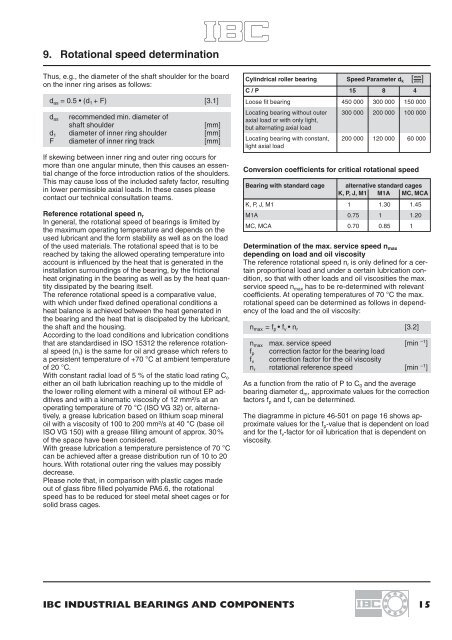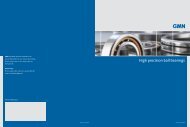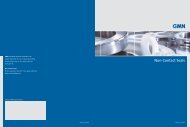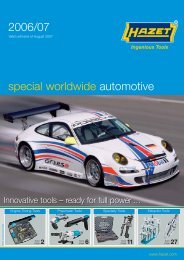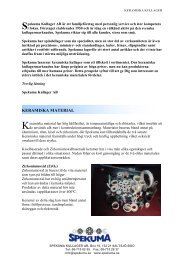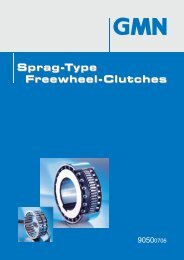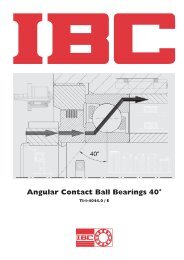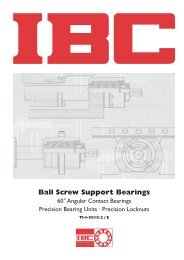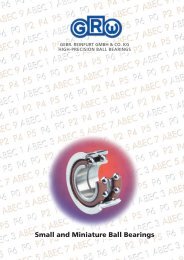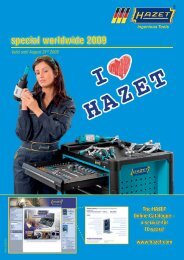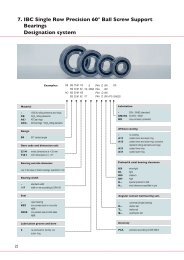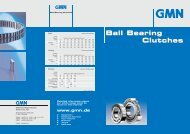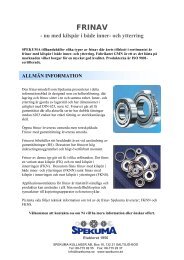IBC Cylindrical Roller Bearings - Spekuma Kullager AB
IBC Cylindrical Roller Bearings - Spekuma Kullager AB
IBC Cylindrical Roller Bearings - Spekuma Kullager AB
Create successful ePaper yourself
Turn your PDF publications into a flip-book with our unique Google optimized e-Paper software.
9. Rotational speed determination<br />
Thus, e.g., the diameter of the shaft shoulder for the board<br />
on the inner ring arises as follows:<br />
d as = 0.5 • (d 1 + F) [3.1]<br />
d as recommended min. diameter of<br />
shaft shoulder<br />
[mm]<br />
d 1 diameter of inner ring shoulder [mm]<br />
F diameter of inner ring track [mm]<br />
If skewing between inner ring and outer ring occurs for<br />
more than one angular minute, then this causes an essential<br />
change of the force introduction ratios of the shoulders.<br />
This may cause loss of the included safety factor, resulting<br />
in lower permissible axial loads. In these cases please<br />
contact our technical consultation teams.<br />
Reference rotational speed n r<br />
In general, the rotational speed of bearings is limited by<br />
the maximum operating temperature and depends on the<br />
used lubricant and the form stability as well as on the load<br />
of the used materials. The rotational speed that is to be<br />
reached by taking the allowed operating temperature into<br />
account is influenced by the heat that is generated in the<br />
installation surroundings of the bearing, by the frictional<br />
heat originating in the bearing as well as by the heat quantity<br />
dissipated by the bearing itself.<br />
The reference rotational speed is a comparative value,<br />
with which under fixed defined operational conditions a<br />
heat balance is achieved between the heat generated in<br />
the bearing and the heat that is discipated by the lubricant,<br />
the shaft and the housing.<br />
According to the load conditions and lubrication conditions<br />
that are standardised in ISO 15312 the reference rotational<br />
speed (n r ) is the same for oil and grease which refers to<br />
a persistent temperature of +70 °C at ambient temperature<br />
of 20 °C.<br />
With constant radial load of 5 % of the static load rating C o<br />
either an oil bath lubrication reaching up to the middle of<br />
the lower rolling element with a mineral oil without EP additives<br />
and with a kinematic viscosity of 12 mm²/s at an<br />
operating temperature of 70 °C (ISO VG 32) or, alternatively,<br />
a grease lubrication based on lithium soap mineral<br />
oil with a viscosity of 100 to 200 mm²/s at 40 °C (base oil<br />
ISO VG 150) with a grease filling amount of approx. 30%<br />
of the space have been considered.<br />
With grease lubrication a temperature persistence of 70 °C<br />
can be achieved after a grease distribution run of 10 to 20<br />
hours. With rotational outer ring the values may possibly<br />
decrease.<br />
Please note that, in comparison with plastic cages made<br />
out of glass fibre filled polyamide PA6.6, the rotational<br />
speed has to be reduced for steel metal sheet cages or for<br />
solid brass cages.<br />
mm<br />
[ min ]<br />
<strong>Cylindrical</strong> roller bearing Speed Parameter d k<br />
C / P 15 8 4<br />
Loose fit bearing 450 000 300 000 150 000<br />
Locating bearing without outer 300 000 200 000 100 000<br />
axial load or with only light,<br />
but alternating axial load<br />
Locating bearing with constant, 200 000 120 000 60 000<br />
light axial load<br />
Conversion coefficients for critical rotational speed<br />
Bearing with standard cage alternative standard cages<br />
K, P, J, M1 M1A MC, MCA<br />
K, P, J, M1 1 1.30 1.45<br />
M1A 0.75 1 1.20<br />
MC, MCA 0.70 0.85 1<br />
Determination of the max. service speed n max<br />
depending on load and oil viscosity<br />
The reference rotational speed n r is only defined for a certain<br />
proportional load and under a certain lubrication condition,<br />
so that with other loads and oil viscosities the max.<br />
service speed n max has to be re-determined with relevant<br />
coefficients. At operating temperatures of 70 °C the max.<br />
rotational speed can be determined as follows in dependency<br />
of the load and the oil viscosity:<br />
n max = f p • f v • n r [3.2]<br />
n max max. service speed [min –1 ]<br />
f p correction factor for the bearing load<br />
f v correction factor for the oil viscosity<br />
n r rotational reference speed [min –1 ]<br />
As a function from the ratio of P to C 0 and the average<br />
bearing diameter d m , approximate values for the correction<br />
factors f p and f v can be determined.<br />
The diagramme in picture 46-501 on page 16 shows approximate<br />
values for the f p -value that is dependent on load<br />
and for the f v -factor for oil lubrication that is dependent on<br />
viscosity.<br />
<strong>IBC</strong> INDUSTRIAL BEARINGS AND COMPONENTS 15


